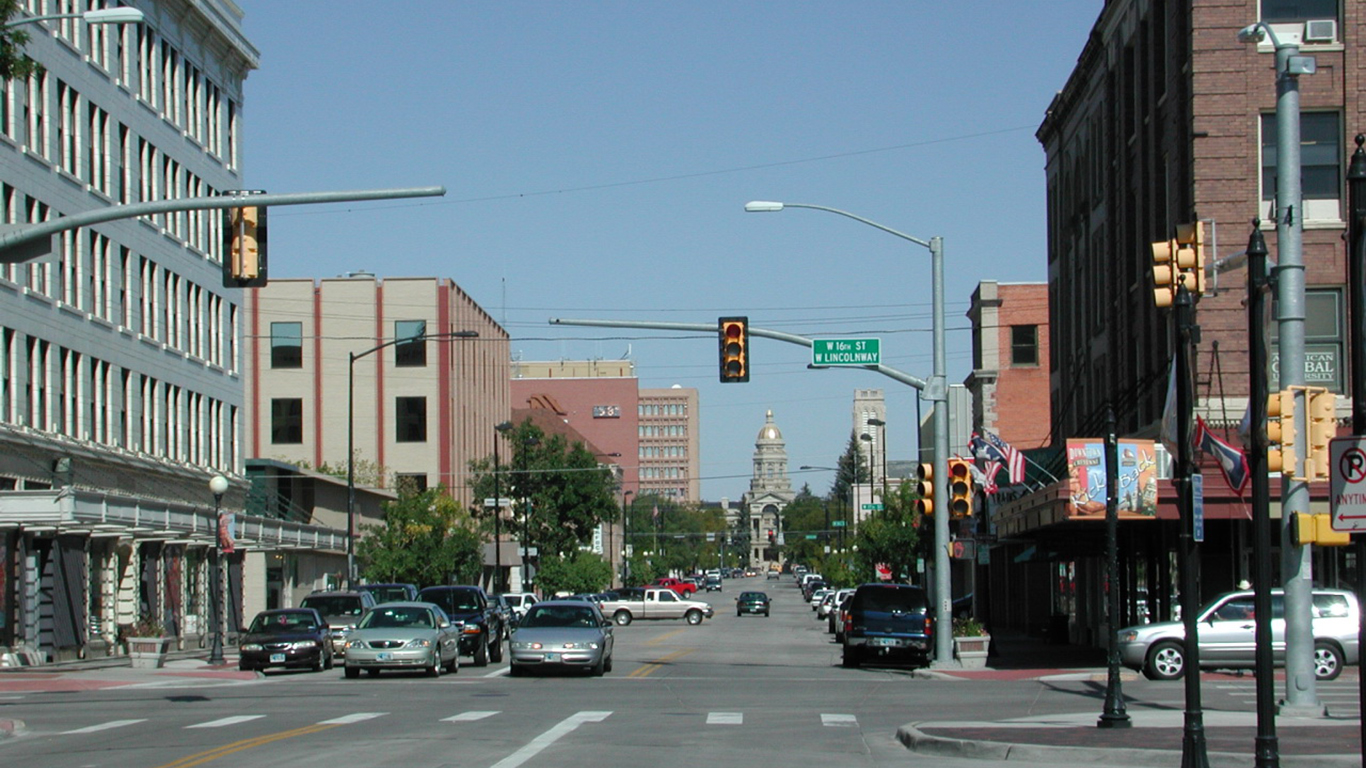Special Report
States Getting the Most COVID-19 Vaccines From the Federal Government

Published:

It has now been 58 weeks since the first shipments of the COVID-19 vaccine were sent out to states, kicking off the largest vaccination campaign in human history. As of January 25, 660,939,155 doses of the vaccine have been sent out across the country — equivalent to 201.4% of the U.S. population.
While the initial distribution of the vaccine took longer than federal projections had indicated, in recent months the U.S. has made great leaps in the worldwide race to administer vaccinations — and some states are faring far better than others. Under the current system, led by the White House COVID-19 Response Team, the Centers for Disease Control and Prevention sends states limited shipments of the vaccine as well as funding and tasks them with distributing the vaccine in accordance with relatively loose federal guidelines. The distribution of the vaccine is based on the size of the adult population in every state, which — according to some experts — can create inequities in states where a larger share of the population is at risk.
At this stage of the vaccine rollout, distribution of the vaccine varies widely from state to state. While the CDC has so far sent out an average of 201,358.8 vaccine doses per 100,000 Americans, Vermont has received 267,635 doses per 100,000 residents — the most of any state. Meanwhile, Wyoming has received 155,758 doses per 100,000, the fewest of any state.
The largest outlier is Wyoming, which has received the fewest doses per capita and is the smallest state.
While the federal government distributes vaccines to states, it is up to state governments to administer the vaccine — creating variations in both the percentage of vaccines that have been administered and the percentage of the population that has been vaccinated. In Wisconsin, 89.8% of vaccine doses have been administered, the most of any state and far greater than the 81.1% national average. In Alabama, 67.1% of vaccine doses have been administered, the least of any state.
At this stage of the rollout, the number of doses administered in Vermont is equivalent to 211.0% of the state population — the largest share of any state. The lowest vaccination rate is in Alabama, where 120.7% of residents have received a dose of the vaccine. Nationwide, the number of doses administered is equivalent to 163.4% of the U.S. population.
While a majority of Americans remain unvaccinated due to a lack of supply, there are some who have no plans to receive a vaccine at all. According to a survey from the U.S. Census Bureau, 64.4% of U.S. adults 18 and over who have not yet received the vaccine will either probably not or definitely not get a COVID-19 vaccine in the future. The most common reason cited for not wanting a vaccine was being concerned about possible side effects. Other commonly cited reasons include not trusting COVID-19 vaccines, not trusting the government, and believing they don’t need a vaccine.
To determine the states getting the most vaccines from the federal government, 24/7 Wall St. reviewed data from the Centers for Disease Control and Prevention. States were ranked based on the number of vaccines administered as of January 25 per 100,000 residents. Vaccine counts were adjusted for population using one-year data from the Census Bureau’s 2019 American Community Survey. Data on confirmed COVID-19 cases as of January 25 came from various state and local health departments and were adjusted for population using 2019 ACS data. Data on the percentage of adults who probably will not or definitely will not get a COVID-19 vaccine and their reasons for not getting one came from the Census Bureau’s Household Pulse Survey, conducted from August 18, 2021 to August 30, 2021.

50. Wyoming
> Vaccines distributed per 100,000: 155,758
> Vaccinations administered as pct. of population: 122.6% (2nd fewest)
> COVID-19 cases per 100,000 residents: 23,390 (16th most)
> Population: 578,759

49. Louisiana
> Vaccines distributed per 100,000: 161,358
> Vaccinations administered as pct. of population: 126.7% (4th fewest)
> COVID-19 cases per 100,000 residents: 22,802 (21st most)
> Population: 4,648,794

48. North Dakota
> Vaccines distributed per 100,000: 166,241
> Vaccinations administered as pct. of population: 137.2% (11th fewest)
> COVID-19 cases per 100,000 residents: 27,693 (2nd most)
> Population: 762,062

47. Mississippi
> Vaccines distributed per 100,000: 168,923
> Vaccinations administered as pct. of population: 122.8% (3rd fewest)
> COVID-19 cases per 100,000 residents: 22,895 (20th most)
> Population: 2,976,149

46. Oklahoma
> Vaccines distributed per 100,000: 169,827
> Vaccinations administered as pct. of population: 140.5% (15th fewest)
> COVID-19 cases per 100,000 residents: 22,591 (23rd most)
> Population: 3,956,971

45. Montana
> Vaccines distributed per 100,000: 170,405
> Vaccinations administered as pct. of population: 140.2% (14th fewest)
> COVID-19 cases per 100,000 residents: 20,780 (17th fewest)
> Population: 1,068,778

44. Tennessee
> Vaccines distributed per 100,000: 171,537
> Vaccinations administered as pct. of population: 135.7% (9th fewest)
> COVID-19 cases per 100,000 residents: 25,423 (5th most)
> Population: 6,829,174

43. Missouri
> Vaccines distributed per 100,000: 172,395
> Vaccinations administered as pct. of population: 137.5% (12th fewest)
> COVID-19 cases per 100,000 residents: 20,692 (16th fewest)
> Population: 6,137,428

42. Idaho
> Vaccines distributed per 100,000: 173,333
> Vaccinations administered as pct. of population: 128.6% (5th fewest)
> COVID-19 cases per 100,000 residents: 20,036 (12th fewest)
> Population: 1,787,065
These are all the counties in Idaho where COVID-19 is slowing (and where it’s still getting worse).

41. Nevada
> Vaccines distributed per 100,000: 176,419
> Vaccinations administered as pct. of population: 147.8% (22nd fewest)
> COVID-19 cases per 100,000 residents: 19,950 (11th fewest)
> Population: 3,080,156
These are all the counties in Nevada where COVID-19 is slowing (and where it’s still getting worse).

40. Indiana
> Vaccines distributed per 100,000: 177,347
> Vaccinations administered as pct. of population: 132.9% (8th fewest)
> COVID-19 cases per 100,000 residents: 22,645 (22nd most)
> Population: 6,732,219

39. Kentucky
> Vaccines distributed per 100,000: 179,351
> Vaccinations administered as pct. of population: 137.7% (13th fewest)
> COVID-19 cases per 100,000 residents: 23,643 (14th most)
> Population: 4,467,673

38. Utah
> Vaccines distributed per 100,000: 179,692
> Vaccinations administered as pct. of population: 148.3% (23rd fewest)
> COVID-19 cases per 100,000 residents: 25,764 (4th most)
> Population: 3,205,958
These are all the counties in Utah where COVID-19 is slowing (and where it’s still getting worse).

37. Alabama
> Vaccines distributed per 100,000: 179,965
> Vaccinations administered as pct. of population: 120.7% (fewest)
> COVID-19 cases per 100,000 residents: 23,518 (15th most)
> Population: 4,903,185

36. Ohio
> Vaccines distributed per 100,000: 180,926
> Vaccinations administered as pct. of population: 143.7% (16th fewest)
> COVID-19 cases per 100,000 residents: 21,440 (23rd fewest)
> Population: 11,689,100
These are all the counties in Ohio where COVID-19 is slowing (and where it’s still getting worse).

35. Wisconsin
> Vaccines distributed per 100,000: 183,208
> Vaccinations administered as pct. of population: 164.6% (21st most)
> COVID-19 cases per 100,000 residents: 24,839 (7th most)
> Population: 5,822,434

34. Arkansas
> Vaccines distributed per 100,000: 184,042
> Vaccinations administered as pct. of population: 131.7% (7th fewest)
> COVID-19 cases per 100,000 residents: 24,476 (11th most)
> Population: 3,017,804

33. Arizona
> Vaccines distributed per 100,000: 184,582
> Vaccinations administered as pct. of population: 152.1% (25th most)
> COVID-19 cases per 100,000 residents: 24,078 (13th most)
> Population: 7,278,717

32. South Carolina
> Vaccines distributed per 100,000: 184,958
> Vaccinations administered as pct. of population: 136.7% (10th fewest)
> COVID-19 cases per 100,000 residents: 24,529 (9th most)
> Population: 5,148,714

31. Georgia
> Vaccines distributed per 100,000: 185,866
> Vaccinations administered as pct. of population: 131.3% (6th fewest)
> COVID-19 cases per 100,000 residents: 21,000 (19th fewest)
> Population: 10,617,423

30. Nebraska
> Vaccines distributed per 100,000: 187,536
> Vaccinations administered as pct. of population: 154.7% (23rd most)
> COVID-19 cases per 100,000 residents: 21,353 (22nd fewest)
> Population: 1,934,408

29. Alaska
> Vaccines distributed per 100,000: 188,328
> Vaccinations administered as pct. of population: 145.2% (18th fewest)
> COVID-19 cases per 100,000 residents: 25,783 (3rd most)
> Population: 731,545
These are all the counties in Alaska where COVID-19 is slowing (and where it’s still getting worse).

28. Kansas
> Vaccines distributed per 100,000: 188,866
> Vaccinations administered as pct. of population: 147.2% (20th fewest)
> COVID-19 cases per 100,000 residents: 23,389 (17th most)
> Population: 2,913,314
These are all the counties in Kansas where COVID-19 is slowing (and where it’s still getting worse).

27. Iowa
> Vaccines distributed per 100,000: 190,470
> Vaccinations administered as pct. of population: 152.4% (24th most)
> COVID-19 cases per 100,000 residents: 21,628 (25th fewest)
> Population: 3,155,070
These are all the counties in Iowa where COVID-19 is slowing (and where it’s still getting worse).

26. North Carolina
> Vaccines distributed per 100,000: 190,792
> Vaccinations administered as pct. of population: 148.9% (25th fewest)
> COVID-19 cases per 100,000 residents: 21,098 (20th fewest)
> Population: 10,488,084

25. South Dakota
> Vaccines distributed per 100,000: 191,390
> Vaccinations administered as pct. of population: 148.9% (24th fewest)
> COVID-19 cases per 100,000 residents: 24,490 (10th most)
> Population: 884,659

24. Michigan
> Vaccines distributed per 100,000: 191,753
> Vaccinations administered as pct. of population: 146.4% (19th fewest)
> COVID-19 cases per 100,000 residents: 21,270 (21st fewest)
> Population: 9,986,857

23. Texas
> Vaccines distributed per 100,000: 194,235
> Vaccinations administered as pct. of population: 147.4% (21st fewest)
> COVID-19 cases per 100,000 residents: 20,466 (14th fewest)
> Population: 28,995,881
These are all the counties in Texas where COVID-19 is slowing (and where it’s still getting worse).

22. New Mexico
> Vaccines distributed per 100,000: 194,423
> Vaccinations administered as pct. of population: 172.7% (15th most)
> COVID-19 cases per 100,000 residents: 20,886 (18th fewest)
> Population: 2,096,829

21. Illinois
> Vaccines distributed per 100,000: 197,505
> Vaccinations administered as pct. of population: 166.0% (20th most)
> COVID-19 cases per 100,000 residents: 21,886 (25th most)
> Population: 12,671,821

20. Colorado
> Vaccines distributed per 100,000: 198,428
> Vaccinations administered as pct. of population: 173.3% (14th most)
> COVID-19 cases per 100,000 residents: 20,592 (15th fewest)
> Population: 5,758,736

19. Florida
> Vaccines distributed per 100,000: 204,166
> Vaccinations administered as pct. of population: 163.7% (22nd most)
> COVID-19 cases per 100,000 residents: 24,899 (6th most)
> Population: 21,477,737

18. Minnesota
> Vaccines distributed per 100,000: 204,467
> Vaccinations administered as pct. of population: 170.1% (18th most)
> COVID-19 cases per 100,000 residents: 21,575 (24th fewest)
> Population: 5,639,632

17. West Virginia
> Vaccines distributed per 100,000: 206,614
> Vaccinations administered as pct. of population: 143.9% (17th fewest)
> COVID-19 cases per 100,000 residents: 23,373 (18th most)
> Population: 1,792,147

16. California
> Vaccines distributed per 100,000: 207,799
> Vaccinations administered as pct. of population: 177.7% (12th most)
> COVID-19 cases per 100,000 residents: 19,160 (10th fewest)
> Population: 39,512,223

15. Virginia
> Vaccines distributed per 100,000: 211,467
> Vaccinations administered as pct. of population: 178.1% (11th most)
> COVID-19 cases per 100,000 residents: 17,162 (7th fewest)
> Population: 8,535,519

14. Washington
> Vaccines distributed per 100,000: 211,742
> Vaccinations administered as pct. of population: 174.4% (13th most)
> COVID-19 cases per 100,000 residents: 15,126 (5th fewest)
> Population: 7,614,893

13. Pennsylvania
> Vaccines distributed per 100,000: 215,465
> Vaccinations administered as pct. of population: 167.1% (19th most)
> COVID-19 cases per 100,000 residents: 20,095 (13th fewest)
> Population: 12,801,989

12. New York
> Vaccines distributed per 100,000: 215,887
> Vaccinations administered as pct. of population: 186.9% (7th most)
> COVID-19 cases per 100,000 residents: 24,127 (12th most)
> Population: 19,453,561

11. Delaware
> Vaccines distributed per 100,000: 216,914
> Vaccinations administered as pct. of population: 171.3% (16th most)
> COVID-19 cases per 100,000 residents: 24,665 (8th most)
> Population: 973,764

10. Oregon
> Vaccines distributed per 100,000: 217,632
> Vaccinations administered as pct. of population: 170.6% (17th most)
> COVID-19 cases per 100,000 residents: 13,536 (2nd fewest)
> Population: 4,217,737
These are all the counties in Oregon where COVID-19 is slowing (and where it’s still getting worse).

9. Connecticut
> Vaccines distributed per 100,000: 223,323
> Vaccinations administered as pct. of population: 197.6% (3rd most)
> COVID-19 cases per 100,000 residents: 18,839 (8th fewest)
> Population: 3,565,287

8. Hawaii
> Vaccines distributed per 100,000: 225,198
> Vaccinations administered as pct. of population: 189.6% (6th most)
> COVID-19 cases per 100,000 residents: 13,955 (3rd fewest)
> Population: 1,415,872
These are all the counties in Hawaii where COVID-19 is slowing (and where it’s still getting worse).

7. Massachusetts
> Vaccines distributed per 100,000: 225,490
> Vaccinations administered as pct. of population: 200.3% (2nd most)
> COVID-19 cases per 100,000 residents: 22,285 (24th most)
> Population: 6,892,503

6. New Jersey
> Vaccines distributed per 100,000: 225,660
> Vaccinations administered as pct. of population: 178.7% (10th most)
> COVID-19 cases per 100,000 residents: 23,279 (19th most)
> Population: 8,882,190

5. Rhode Island
> Vaccines distributed per 100,000: 228,710
> Vaccinations administered as pct. of population: 195.3% (5th most)
> COVID-19 cases per 100,000 residents: 30,878 (most)
> Population: 1,059,361

4. Maine
> Vaccines distributed per 100,000: 228,919
> Vaccinations administered as pct. of population: 196.5% (4th most)
> COVID-19 cases per 100,000 residents: 12,416 (fewest)
> Population: 1,344,212
These are all the counties in Maine where COVID-19 is slowing (and where it’s still getting worse).

3. New Hampshire
> Vaccines distributed per 100,000: 230,058
> Vaccinations administered as pct. of population: 186.8% (8th most)
> COVID-19 cases per 100,000 residents: 18,959 (9th fewest)
> Population: 1,359,711

2. Maryland
> Vaccines distributed per 100,000: 237,404
> Vaccinations administered as pct. of population: 183.1% (9th most)
> COVID-19 cases per 100,000 residents: 15,476 (6th fewest)
> Population: 6,045,680

1. Vermont
> Vaccines distributed per 100,000: 267,635
> Vaccinations administered as pct. of population: 211.0% (most)
> COVID-19 cases per 100,000 residents: 14,272 (4th fewest)
> Population: 623,989
Click here to see all coronavirus data for every state.
Retirement planning doesn’t have to feel overwhelming. The key is finding expert guidance—and SmartAsset’s simple quiz makes it easier than ever for you to connect with a vetted financial advisor.
Here’s how it works:
Why wait? Start building the retirement you’ve always dreamed of. Click here to get started today!
Thank you for reading! Have some feedback for us?
Contact the 24/7 Wall St. editorial team.